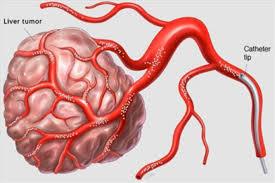Breakthrough Y-90 Treatment Targets Liver Tumors
Patients with colorectal cancer that has spread to the liver now have another treatment option called selective internal radiation therapy (SIRT). This revolutionary therapy is an FDA-approved, non-surgical treatment that uses tiny beads called microspheres to deliver radiation directly to tumors in the liver.
 Directed Radiation into the Tumor
Directed Radiation into the Tumor
“The microspheres contain the radioactive element Y-90, which is delivered through the hepatic artery and directly into the liver’s blood vessels to kill cancer cells,” explains Feraz Rahman, M.D., board-certified interventional radiologist. “By directing high doses of radiation precisely into the tumor, healthy liver tissue can be preserved.”
Of the nearly 140,000 Americans diagnosed with colorectal cancer every year, at least 60 percent will see their cancer spread to the liver. SIRT is only suitable for patients whose liver is the only site of cancer, or the liver is the major site of the disease. SIRT has no effect on tumors outside the liver.
Shrinks Liver Tumors
Clinical studies have shown that when used in combination with chemotherapy, Y-90 microspheres can shrink liver tumors more than chemotherapy alone, improve quality of life and increase life expectancy,” adds Ashish Vyas, M.D., who also performs the procedure at Silver Cross.
Due to the liver tumor's unique blood supply, millions of tiny spheres are delivered directly to the tumors, blocking the supply of blood to the cancer cells and delivering a high dose of radiation to the tumor. SIRT can help extend the lives of patients with inoperable tumors and improve their quality of life.
“Typically, patients undergo two procedures,” Dr. Rahman added. “Both include a procedure known as an angiogram and are performed under conscious sedation.”
2-Step Procedure
The purpose of the first angiogram (called mapping) is to prepare the liver for SIRT. During the mapping procedure, the interventional radiologist blocks the vessels to minimize the potential for the Y-90 microspheres to travel to areas outside the liver, such as the stomach or intestine. Assuming that the results of the initial tests are acceptable, the prescribed dose of Y-90 microspheres will then be administered under a second procedure, which is usually conducted one or two weeks after the initial angiogram is completed.
For a small number of patients, treatment can shrink the tumor enough that it can be removed by surgery at a later date.
Normally, patients can be discharged within four to six hours of the procedure and are able to resume normal daily activities two to three days after treatment.